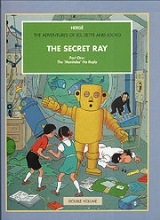
Jo, Zette and Jocko
Encyclopedia
The Adventures of Jo, Zette and Jocko is a comic book
(or bande dessinée
) series created by Hergé
, the Belgian
writer-artist who was best known for The Adventures of Tintin
. The heroes of the series are two young children, brother and sister Jo and Zette Legrand and their pet monkey
Jocko.
Jo, Zette and Jocko appear on the rear covers of some editions of The Adventures of Tintin
series but never appear in the stories, while there are a few cheeky allusions to the cosmos of the Tintin adventures within the Jo, Zette and Jocko albums.
, Hergé was approached by Father Courtois, director of the weekly French newspaper Coeurs Vaillants (Valiant Hearts). Coeurs Vaillants also published Tintin's adventures, but while Father Courtois enjoyed Tintin, he wanted a set of characters that would embody classical family values — a young boy, with a father who works, a mother, a sister and a pet — in contrast to the more independent Tintin who, the whole of his career, has had no mention of relatives at all.
Inspired by a toy monkey called Jocko, Hergé created Jo Legrand, his sister Zette and their pet monkey Jocko as well as their engineer father, Jacques, and housewife mother. Their first adventure, The Secret Ray appeared in the pages of Coeurs Vaillants on January 19, 1936 and ran until June 1937. It was also published in Le Petit Vingtième
itself.
Between 1936 and 1957, three complete Jo, Zette and Jocko adventures would be published, spread across five albums. Hergé however often felt restricted by the family set-up: whereas the older, more independent Tintin could just head off on any adventure, either alone or with Captain Haddock
or Professor Calculus
, this was not possible for Jo, Zette and Jocko whose parents had to figure large in any adventure — usually to act as their rescuers. The stories also lacked the social and political messages of the Tintin stories
. In the end, these constraints led him to eventually abandon Jo, Zette and Jocko in the late-1950s.
(1972), which was not produced by Hergé himself but issued under his name, appears to borrow some elements from the Jo, Zette and Jocko adventure The Secret Ray:
is the sixth, incomplete, Jo, Zette and Jocko adventure. It began in 1958 as a Tintin adventure of the same name. Hergé had asked the French comic book creator Greg (Michel Regnier) to provide a scenario for a new Tintin story. Greg came up with two potential plots: Les Pilules (The Pills) and Le Thermozéro. Hergé made sketches of the first eight pages of Le Thermozéro before the project was abandoned in 1960 – Hergé deciding that he wished to retain sole creative control of his work.
Sometime after this, Hergé sought to resurrect Le Thermozéro as a Jo, Zette and Jocko adventure and instructed his long time collaborator Bob de Moor
to work on an outline. Bernard Tordeur of the Hergé Foundation has suggested, at the World of Tintin Conference held at the National Maritime Museum
, Greenwich
on May 15, 2004, that a complete draft outline (similar to what survives of Tintin and Alph-Art
) was completed before the project was terminated This draft version of the book apparently survives in the Tintin Archives.
in 1986. Mr Pump’s Legacy and Destination New York followed in 1987.
The ‘Manitoba’ No Reply and The Eruption of Karamako remained unpublished (possibly due to Hergé’s unsympathetic depiction of the primitive natives of the island of Karamako, similar to Tintin in the Congo
) until 1994 when they were published together in a single limited-edition double volume titled The Secret Ray.
Footnotes
Comic book
A comic book or comicbook is a magazine made up of comics, narrative artwork in the form of separate panels that represent individual scenes, often accompanied by dialog as well as including...
(or bande dessinée
Franco-Belgian comics
Franco-Belgian comics are comics that are created in Belgium and France. These countries have a long tradition in comics and comic books, where they are known as BDs, an abbreviation of bande dessinée in French and stripverhalen in Dutch...
) series created by Hergé
Hergé
Georges Prosper Remi , better known by the pen name Hergé, was a Belgian comics writer and artist. His best known and most substantial work is the 23 completed comic books in The Adventures of Tintin series, which he wrote and illustrated from 1929 until his death in 1983, although he was also...
, the Belgian
Belgium
Belgium , officially the Kingdom of Belgium, is a federal state in Western Europe. It is a founding member of the European Union and hosts the EU's headquarters, and those of several other major international organisations such as NATO.Belgium is also a member of, or affiliated to, many...
writer-artist who was best known for The Adventures of Tintin
The Adventures of Tintin
The Adventures of Tintin is a series of classic comic books created by Belgian artist , who wrote under the pen name of Hergé...
. The heroes of the series are two young children, brother and sister Jo and Zette Legrand and their pet monkey
Monkey
A monkey is a primate, either an Old World monkey or a New World monkey. There are about 260 known living species of monkey. Many are arboreal, although there are species that live primarily on the ground, such as baboons. Monkeys are generally considered to be intelligent. Unlike apes, monkeys...
Jocko.
Jo, Zette and Jocko appear on the rear covers of some editions of The Adventures of Tintin
The Adventures of Tintin
The Adventures of Tintin is a series of classic comic books created by Belgian artist , who wrote under the pen name of Hergé...
series but never appear in the stories, while there are a few cheeky allusions to the cosmos of the Tintin adventures within the Jo, Zette and Jocko albums.
Publication history
In 1935, six years after Tintin had first appeared in the pages of Le Petit VingtièmeLe Petit Vingtième
Le Petit Vingtième was the weekly youth supplement to the Belgian newspaper Le Vingtième Siècle from 1928 to 1940. The comics series The Adventures of Tintin first appeared in its pages.-History:...
, Hergé was approached by Father Courtois, director of the weekly French newspaper Coeurs Vaillants (Valiant Hearts). Coeurs Vaillants also published Tintin's adventures, but while Father Courtois enjoyed Tintin, he wanted a set of characters that would embody classical family values — a young boy, with a father who works, a mother, a sister and a pet — in contrast to the more independent Tintin who, the whole of his career, has had no mention of relatives at all.
Inspired by a toy monkey called Jocko, Hergé created Jo Legrand, his sister Zette and their pet monkey Jocko as well as their engineer father, Jacques, and housewife mother. Their first adventure, The Secret Ray appeared in the pages of Coeurs Vaillants on January 19, 1936 and ran until June 1937. It was also published in Le Petit Vingtième
Le Petit Vingtième
Le Petit Vingtième was the weekly youth supplement to the Belgian newspaper Le Vingtième Siècle from 1928 to 1940. The comics series The Adventures of Tintin first appeared in its pages.-History:...
itself.
Between 1936 and 1957, three complete Jo, Zette and Jocko adventures would be published, spread across five albums. Hergé however often felt restricted by the family set-up: whereas the older, more independent Tintin could just head off on any adventure, either alone or with Captain Haddock
Captain Haddock
Captain Archibald Haddock is a fictional character in The Adventures of Tintin, the series of classic Belgian comic books written and illustrated by Hergé...
or Professor Calculus
Professor Calculus
Professor Cuthbert Calculus is a fictional character in The Adventures of Tintin, the series of classic Belgian comic books written and illustrated by Hergé...
, this was not possible for Jo, Zette and Jocko whose parents had to figure large in any adventure — usually to act as their rescuers. The stories also lacked the social and political messages of the Tintin stories
Ideology of Tintin
Hergé started drawing his comics series The Adventures of Tintin in 1929 for Le Petit Vingtième, the children's section of the Belgian newspaper Le Vingtième Siècle, run by the Abbé Norbert Wallez, an avid supporter of social Catholicism, a right-wing movement...
. In the end, these constraints led him to eventually abandon Jo, Zette and Jocko in the late-1950s.
The Secret Ray
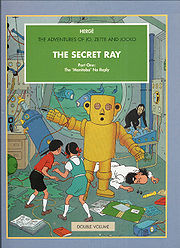 |
1. The ‘Manitoba’ No Reply (Le Manitoba ne répond plus) (Volume 1 of The Secret Ray) The transatlantic liner Ocean liner An ocean liner is a ship designed to transport people from one seaport to another along regular long-distance maritime routes according to a schedule. Liners may also carry cargo or mail, and may sometimes be used for other purposes .Cargo vessels running to a schedule are sometimes referred to as... Manitoba breaks down on its way to England England England is a country that is part of the United Kingdom. It shares land borders with Scotland to the north and Wales to the west; the Irish Sea is to the north west, the Celtic Sea to the south west, with the North Sea to the east and the English Channel to the south separating it from continental... and then the passengers and crew fall strangely asleep. When they wake up it is to find that they have all been robbed of their valuables. Later, while on holiday at the seaside, Jo, Zette and Jocko, playing in a rowing boat, get lost at sea when a thick fog comes down. Rescued by a submarine Submarine A submarine is a watercraft capable of independent operation below the surface of the water. It differs from a submersible, which has more limited underwater capability... , they are taken to a secret undersea base where a mad scientist has plans for the two young children. |
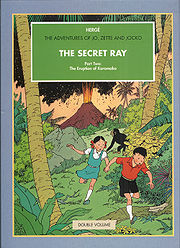 |
2. The Eruption of Karamako (L’Eruption du Karamako) (Volume 2 of The Secret Ray) Jo, Zette and Jocko escape the undersea base in an amphibious tank, and end up on an island. But their problems are far from over. They have to deal with cannibals, modern-day pirates Piracy Piracy is an act of robbery or criminal violence at sea. The term can include acts committed on land, in the air, or in other major bodies of water or on a shore. It does not normally include crimes committed against persons traveling on the same vessel as the perpetrator... , an erupting volcano Volcano 2. Bedrock3. Conduit 4. Base5. Sill6. Dike7. Layers of ash emitted by the volcano8. Flank| 9. Layers of lava emitted by the volcano10. Throat11. Parasitic cone12. Lava flow13. Vent14. Crater15... , gangsters, the media Mass media Mass media refers collectively to all media technologies which are intended to reach a large audience via mass communication. Broadcast media transmit their information electronically and comprise of television, film and radio, movies, CDs, DVDs and some other gadgets like cameras or video consoles... and there is still the mad scientist who wants them for his evil plans. (In one scene Zette is harassed by a representative of Cosmos Pictures which was run by Tintin's enemy Rastapopoulos Rastapopoulos Roberto Rastapopoulos is a fictional character in The Adventures of Tintin, the series of classic Belgian comic books written and illustrated by Hergé. He is the antagonist in many of Tintin's adventures.... .) |
Mr. Pump’s Legacy
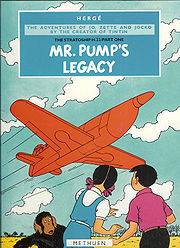 |
3. Mr. Pump’s Legacy (Le Testament de Monsieur Pump) (Volume 1 of The Stratoship H.22) Killed while exercising his love for speed in a racing car, millionaire John Archibald Pump leaves behind ten million dollars (a staggeringly large sum for those days). It will go to the builders of the first aeroplane to fly from Paris to New York at 1000 kilometres per hour. Jo and Zette's father sets about designing such a plane, but the project comes under threat from a gang of saboteurs led by William and Fred Stockrise, Pump's passed-over nephews, who go to all lengths, from theft to bombing, to prevent it. (A framed photo of Captain Haddock can be seen hanging on the wall of the Legrand living-room just before Mr Legrand switches on the light to confront intruders.) |
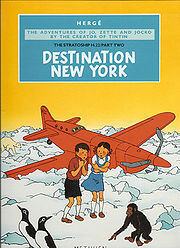 |
4. Destination New York (Destination New York) (Volume 2 of The Stratoship H.22) When the Stratoship H.22, designed by their father, is the subject of an attempted bombing from the air, Jo and Zette fly it out of its hangar Hangar A hangar is a closed structure to hold aircraft or spacecraft in protective storage. Most hangars are built of metal, but other materials such as wood and concrete are also sometimes used... but are unable to get back. Crash-landing near the North Pole North Pole The North Pole, also known as the Geographic North Pole or Terrestrial North Pole, is, subject to the caveats explained below, defined as the point in the northern hemisphere where the Earth's axis of rotation meets its surface... they face a race against time to get the plane back home and win the trans-Atlantic challenge. But the Stockrise brothers and their gang are still determined to thwart the operation even if it is successful. |
The Valley of the Cobras
5. The Valley of the Cobras (La Vallée des cobras) The Maharajah of Gopal is a bad-tempered sort of person, whose behaviour ranges from the childish to the eccentric, and his long-suffering secretary Badalah is usually on the receiving end. Nevertheless, Jo and Zette's father agrees to build him a bridge in his kingdom. The problem is there is a group of scoundrels led by Prime Minister Ramahjuni and the evil fakir Rabindah who aren't too keen on the idea. |
Influence on other works
Aspects of the animated film Tintin and the Lake of SharksTintin and the Lake of Sharks
Tintin and the Lake of Sharks is a Tintin animated film, directed by Raymond Leblanc . It was not written by Hergé, who supervised, but by the Belgian comics creator Greg , a friend of Hergé...
(1972), which was not produced by Hergé himself but issued under his name, appears to borrow some elements from the Jo, Zette and Jocko adventure The Secret Ray:
- like in The ‘Manitoba’ No Reply, two children, Niko and Nushka, attempt to escape from an underwater base in a tankTankA tank is a tracked, armoured fighting vehicle designed for front-line combat which combines operational mobility, tactical offensive, and defensive capabilities...
-like vehicle; - like in The Eruption of Karamako, the underwater compound is destroyed by its evil leader in an attempt to drown his pursuers;
- there is the interaction of children and adults during the final escape;
- and the friends waiting above water and thinking the heroes have been killed when the compound explodes.
Le Thermozéro
Le ThermozéroLe Thermozéro
Le Thermozéro is an abandoned comics project from two of Hergé's series : The Adventures of Tintin as well as Jo, Zette and Jocko.-History:...
is the sixth, incomplete, Jo, Zette and Jocko adventure. It began in 1958 as a Tintin adventure of the same name. Hergé had asked the French comic book creator Greg (Michel Regnier) to provide a scenario for a new Tintin story. Greg came up with two potential plots: Les Pilules (The Pills) and Le Thermozéro. Hergé made sketches of the first eight pages of Le Thermozéro before the project was abandoned in 1960 – Hergé deciding that he wished to retain sole creative control of his work.
Sometime after this, Hergé sought to resurrect Le Thermozéro as a Jo, Zette and Jocko adventure and instructed his long time collaborator Bob de Moor
Bob de Moor
Bob de Moor is the pen name of Robert Frans Marie De Moor , a Belgian comics creator. Chiefly noted as an artist, he is considered an early master of the Ligne claire style. He wrote and drew several comics series on his own, but also collaborated with Hergé on several volumes of The Adventures of...
to work on an outline. Bernard Tordeur of the Hergé Foundation has suggested, at the World of Tintin Conference held at the National Maritime Museum
National Maritime Museum
The National Maritime Museum in Greenwich, England is the leading maritime museum of the United Kingdom and may be the largest museum of its kind in the world. The historic buildings forming part of the Maritime Greenwich World Heritage Site, it also incorporates the Royal Observatory, Greenwich,...
, Greenwich
Greenwich
Greenwich is a district of south London, England, located in the London Borough of Greenwich.Greenwich is best known for its maritime history and for giving its name to the Greenwich Meridian and Greenwich Mean Time...
on May 15, 2004, that a complete draft outline (similar to what survives of Tintin and Alph-Art
Tintin and Alph-Art
Tintin and Alph-Art was the intended twenty-fourth and final book in the Tintin series, created by Belgian comics artist Hergé. It is a striking departure from the earlier books in tone and subject, as well as in some parts of the style; rather than being set in a usual exotic and action-packed...
) was completed before the project was terminated This draft version of the book apparently survives in the Tintin Archives.
English translations
The Valley of the Cobras was the first Jo, Zette and Jocko adventure to be translated and published in EnglishEnglish language
English is a West Germanic language that arose in the Anglo-Saxon kingdoms of England and spread into what was to become south-east Scotland under the influence of the Anglian medieval kingdom of Northumbria...
in 1986. Mr Pump’s Legacy and Destination New York followed in 1987.
The ‘Manitoba’ No Reply and The Eruption of Karamako remained unpublished (possibly due to Hergé’s unsympathetic depiction of the primitive natives of the island of Karamako, similar to Tintin in the Congo
Tintin in the Congo
Tintin in the Congo is the second title in the comicbook series The Adventures of Tintin, written and drawn by Belgian cartoonist Hergé. Originally serialised in the Belgian children's newspaper supplement, Le Petit Vingtième between June 1930 and July 1931, it was first published in book form...
) until 1994 when they were published together in a single limited-edition double volume titled The Secret Ray.
Sources
- Jo, Zette et Jocko publications in Belgian Tintin and French Tintin BDoubliées
Footnotes

